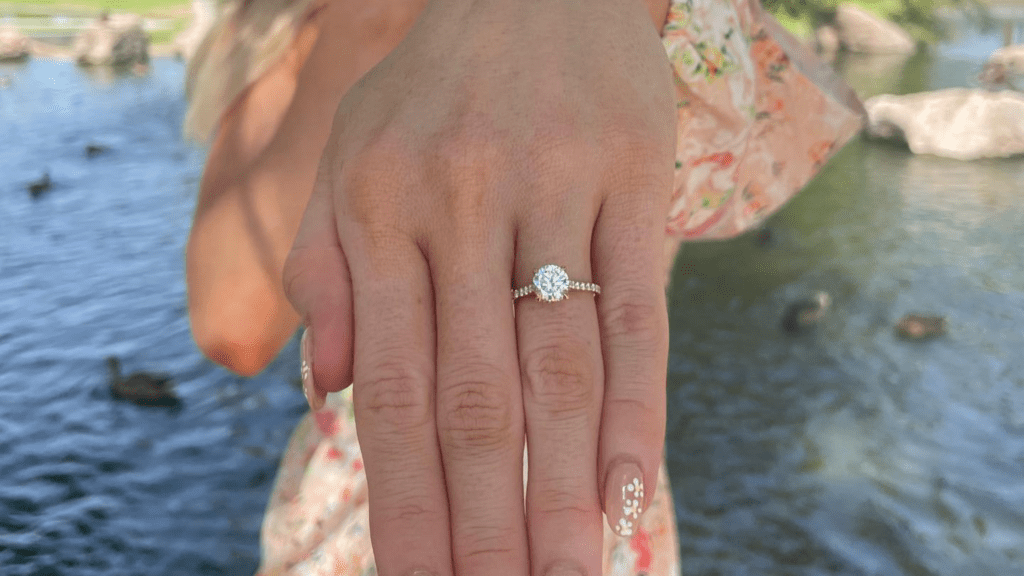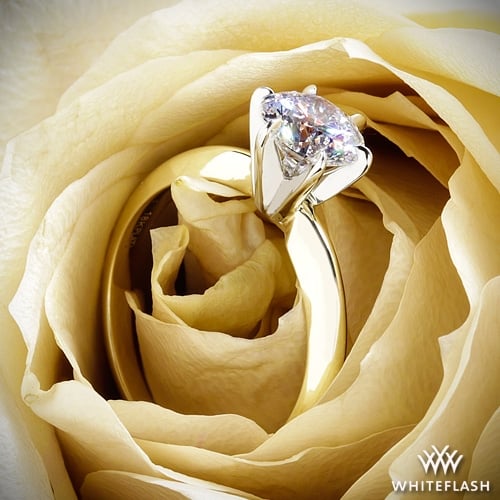Many moons ago, a young man named John was ready to propose to his beloved, Sarah. He knew she deserved nothing but the best, a gem as unique and beautiful as she was. His quest led him to the pursuit of the perfect 1-carat diamond ring. However, little did he know that such a seemingly simple task was fraught with complexities and nuances. As he delved deeper, he realized the world of diamonds was vast and intricate, filled with confusing terms and criteria.
John’s journey, like so many others’, began with wonder and excitement but quickly transformed into an overwhelming puzzle. The range of prices, the importance of cut, clarity, color, and carat weight – each factor was significant in its own right. It was a lot to process, but John was determined.
His dedication led him to extensive research, understanding how diamonds were not mere stones but storied entities, each holding a unique tale within their brilliant facets. Only after this realization did John find the perfect 1-carat diamond ring for Sarah, an engagement ring that held as much significance and value as their love story.
Much like John, you may find the quest for a 1-carat diamond ring overwhelming. But don’t worry, our comprehensive guide is here to illuminate your path and help you navigate this fascinating world. From cost and cut quality to color, clarity, and shape – we’ve got you covered, helping you find a diamond that will keep sparkling for generations. After all, every diamond has a story, just like every love story has a diamond.

Understanding the Costs
Not all diamonds are equal. It would be best to consider several factors when purchasing a 1-carat diamond engagement ring. Many criteria can affect the price and overall beauty of the diamond. A 1-carat diamond can fall within a vast range from about $1,800 to $12,000, depending on various factors such as cut quality, clarity, color, and shape. Following the 4 Cs to a quality diamond will help to elevate your shopping experience.
Staying updated with the current market prices is crucial when investing in diamonds. PriceScope's latest diamond prices chart provides real-time data on 1-carat diamonds, helping you make a wise investment decision. Stay informed and get the best value for your money with PriceScope.
Cut Quality for 1-Carat Diamonds
Cut quality is one of the most critical factors impacting both the price and beauty of a 1–carat diamond. The better the cut quality, the higher the value and the more light-reactive the diamond will appear. We recommended choosing a diamond with an ideal – excellent cut grade to maximize its sparkle, brilliance, and fire.
1-Carat Diamond Sizes
Carat weight refers to the weight of the diamond and is not a direct measurement of its size. A 1–carat diamond weighs approximately 0.2 grams. The size of a 1–carat diamond can vary depending on its shape. For example, a 1–carat round diamond cut to ideal proportions is approximately 6.5mm in diameter. Different diamond shapes may have larger or smaller surface areas.
1-Carat Diamond Clarity
Regarding diamond clarity, choosing a minimum clarity grade of SI1 for a 1-carat diamond is generally recommended. Most inclusions and blemishes in this range will be invisible to the naked eye. However, it’s always advisable to review the diamond’s clarity yourself or seek assistance from an expert.
1-Carat Diamond Color
Diamond color is another important consideration. We encourage you to choose a diamond in the G-I range, considered nearly colorless. To the naked eye, diamonds in this range will appear as colorless as those in the higher D-F range but at a lower cost. Cut quality is more important than color when determining a diamond’s beauty. Color is still a valuable element, but this is more of a personal aesthetic choice. Some buyers prefer warmth in their diamonds and take a lower color grade to achieve it.
Ready to embark on your diamond buying journey? Use PriceScope's advanced Diamond Search tool to filter through a vast selection of 1-carat diamonds by cut, color, clarity, and more. Make an informed choice that suits your taste and budget. Start your search today!
1-Carat Diamond Engagement Ring Inspiration
After exploring our comprehensive guide on 1-carat diamonds, why not use our Jewelry Search function to find the perfect setting? From classic solitaire to modern halo designs, find the ideal home for your chosen diamond. Discover the endless possibilities today.
Choosing the Right Diamond Shape
The shape of a diamond refers to its physical form, and there are many different shapes to choose from. While round cut diamonds are the most popular, many other shapes, known as ‘fancy cuts’, are equally stunning and might better suit your personal style or the style of the wearer.
Round Cut: The round cut diamond is the most popular diamond shape, representing approximately 75% of all diamonds sold. It is also generally the most expensive due to its demand and the fact that more rough diamond is lost in the cutting process. Shop Round Cut Diamonds at Whiteflash
Princess Cut: This is the second most popular shape. The princess cut is traditionally a square shape with sharp, pointed corners. It is less expensive than the round cut because less rough diamond is wasted during the cutting process. Shop Princess Cut Diamonds at PriceScope
Oval Cut: The elongated shape of the oval cut can create the illusion of greater size. The slender shape can also make the finger of the wearer appear longer and slimmer. Shop Oval Cut Diamonds at PriceScope
Pear Cut: Also known as the teardrop shape, the pear cut is both unique and beautiful. It can be worn with the pointed end towards or away from the hand, and the length of the shape can make the fingers appear longer. Shop Pear Cut Diamonds at PriceScope
Cushion Cut: The cushion cut has gained popularity over the past decade. It has a square or rectangular shape with rounded corners, resembling a pillow or ‘cushion,’ hence the name. Shop Cushion Cut Diamonds at PriceScope
Emerald Cut: This shape is more about the clarity of the diamond, as its large, open table (the flat facet on the diamond’s surface) can highlight any inclusions or blemishes. The elongated shape and step cuts of its facets create a sophisticated, glamorous appearance. Shop Emerald Cut Diamonds at PriceScope
Asscher Cut: The Asscher cut is a stepped square cut, often called the “square emerald cut.” It has cropped corners and showcases the clarity of the diamond. Shop Asscher Cut Diamonds at PriceScope
Marquise Cut: This football-shaped cut can maximize carat weight, giving the appearance of a much larger diamond. The long, narrow shape can also make fingers look longer and more slender. Shop Marquise Cut Diamonds at PriceScope
Radiant Cut: The radiant cut combines the emerald cut’s stylish lines with the round cut’s brilliance. It’s a versatile cut that can be used in various ring styles. Shop Radiant Cut Diamonds at PriceScope
Heart Cut: A less common shape, the heart cut diamond is a symbol of love. The complexity of the shape requires a high degree of skill to ensure the proper symmetry and proportion, so it’s essential to find a reputable jeweler. Shop Heart Cut Diamonds at James Allen, and Blue Nile
The shape of the diamond can significantly influence the aesthetic of your ring. Some shapes can make the diamond appear larger, while others highlight the diamond’s clarity. Ultimately, the best shape to choose is the one that most appeals to you or your loved one. Check out the popular diamond shapes on the market in real-time. **Updated monthly at PriceScope

Reasons Why It’s Important To Purchase A Certified 1-Carat Diamond
- Authenticity: Certification from a reputable lab guarantees that the diamond is real and not a synthetic or a look-alike stone such as cubic zirconia or moissanite.
- Quality Verification: A certified diamond comes with a report detailing its specifications, including the 4Cs—Carat, Cut, Color, and Clarity. This document verifies the diamond’s quality and provides transparency about its characteristics, enabling you to understand exactly what you’re buying.
- Value for Money: Certification helps to ensure that you’re paying a fair price for the diamond. By knowing the precise quality and characteristics of the diamond, you can compare prices across different sellers and make a more informed decision.
- Resale Value: If you ever decide to sell or trade-in your diamond in the future, the certification will play a crucial role. Certified diamonds typically have higher resale values because the next buyer or jeweler can be confident about the diamond’s quality.
- Insurance: In case of loss or damage, insurance companies usually require detailed information about the diamond, which is readily available in the certificate. This documentation helps establish the diamond’s value and replace it accurately.
Certification doesn’t just provide assurance—it is a critical tool for comparing diamonds, understanding their worth, and ensuring your investment is sound. It’s important to ensure the diamond is certified by a reputable institution such as the Gemological Institute of America (GIA), the American Gem Society (AGS), or the International Gemological Institute (IGI). These organizations are known for their rigorous standards and unbiased evaluations.
Final Thoughts
To get the best value for a 1-carat diamond, we recommend focusing on its cut, color, clarity, and shape. We encourage you to purchase a diamond with a reputable certificate. Buying from a PriceScope vendor will always be a great place to start.
It’s important to note that diamond prices are often subjective and driven by emotions. Finding a trusted diamond dealer and selecting a diamond with a GIA certificate are crucial steps to ensure the quality and authenticity of the diamond.
In conclusion, purchasing a 1-carat diamond engagement ring requires careful consideration of various factors such as cut, color, clarity, and shape. By following expert recommendations and conducting thorough research, you can find a high-quality and beautiful diamond at an excellent value.
Join the PriceScope online community and connect with other diamond enthusiasts. Share your journey of choosing between a 1-carat, 2-carat, and 3-carat diamond, gain insights from others' experiences, and ask for advice from seasoned buyers and industry experts. Become a part of our vibrant community today.






